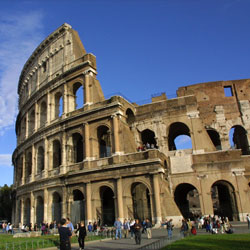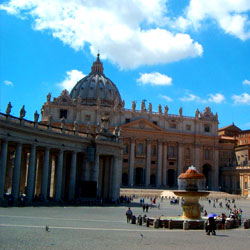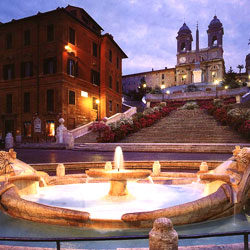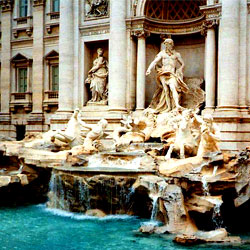

It was said that "When the Colosseum perishes, also the Rome perishes with the whole world at the same time". Actually, the Colosseum Amphitheater is representative of the city of Rome. It had been built in 80 AD by the order of Emperor Vespasian. It's said that at the time this "stadium" had hold max. 50,000 people.
As you can see some film like "Gladiator", it had been used as a gladiatorial arena in Roman times (and the beast had been used sometimes) to watch the brutal fights.
Still now you can see the beast cage sites.

Michelangelo, praised this temple as a "Design of Angels". The first original Pantheon had been built from 25 BC to 27 BC by Agrippa. Subsequently it had been destroyed by fire, and the actual Pantheon building had been rebuilt from 118 to 128 AD by the Roman Emperor Hadrian.
The front has a long row of the pillars of ancient Greek architecture and the interior dome is characterized by a vacant skylight of 9 meter in diameter. This skylight with hole in the center of the ceiling is protected by air pressure from the inside of the building and even if it rains, the rainwater cannot come in.

Vatican City (Stato della Citta' del Vaticano) located in Rome is ruled by the papacy, the world's smallest sovereign state. It was established in 1929, and includes the Vatican palace and Saint Peter's Basilica in the area of 0.44 square kilometers with about 1,000 people.
Recently a new pope has been elected and some books and filmslike "Da Vinci Code" made a big success in the world. Therefore the number of tourists has increased drastically. Due to there recent events, a strict baggage check is necessary done.
Vatican City is also the headquarter of the Catholic Church and itself is a treasure trove of precious cultural heritages. St. Peter's Basilica and the Sistine Chapel are full of great masterpieces of Botticelli, Bernini and Michelangelo etc. The Vatican Museums and the Vatican document archives conserve also a large number of valuable historical collections. In 1984 the Vatican city itself has been registered as a World Heritage Site.
Comments from travelers St. Peter's Basilica is a treasure trove of rare and important works of art. There are many representative works by Bernini in particular. |

One of the world's most famous squares is this "Piazza di Spagna". You can remember a familiar scene of the film "Roman Holiday". The princess played by Audrey Hepburn was eating a gelato in this square.
In the center of this square, there is a fountain of a boat "Fontana della Barcaccia" by Pietro Bernini (Gian Lorenzo Bernini's father). Behind this fountain, the Spanish Steps (the official name is Trinita' de Monti staircase) go up to the Trinita de Monti Church on the top of the hill.
In recent years, due to the bad behavior of tourists and local young people, it has been banned from drinking alcohol like beer and wine on the stairs.
From the Piazza di Spagna, the "Via Condotti" is extending. It's also known as a "brand street" with many famous luxury boutiques like Gucci and Prada.

Even if it's constantly filled with tourists, please don't miss this magnificent "Trevi Fountain". There is a famous legendary episode : flipping a coin over your shoulder to the fountain behind, you can come back to Rome again. In the Federico Fellini's classic film "La Dolce Vita", Anita Ekberg was taking a bath in the Trevi water.
Nicola Salvi, who won the competition sponsored by the Pope Clement XII, designed this fountain. It had been completed after his death in 1762. Baroque design integrated with the Poli palace's walls is characteristic.